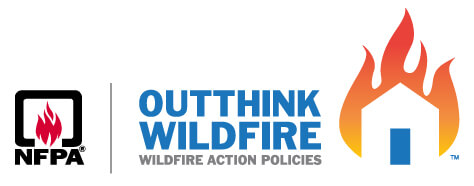Outhinking Wildfire
NFPA program aims to end wildfire disasters through public policy
by MICHELE STEINBERG
In a move that reaches beyond its usual advocacy role, the National Fire Protection Association has launched Outthink Fire™, a plan to end the destruction of communities by wildfire within 30 years through policy change.
Catastrophic fires that have devastated communities around the world have been a wake-up call to explore what organizations and individuals can do differently to end losses from wildfire.
Outthink Wildfire is a new approach, but its five tenets – which must be supported by all levels of government – are familiar. The plan calls for
- more care to make homes and businesses ignition resistant through new building and land-use requirements, and through retrofitting and mitigating existing structures
- policymakers and governments to take the needs of local fire departments seriously by providing wildfire training and personal protective equipment
- government to pick up the pace on hazardous fuel management across all lands
- more public education about how to protect homes and families, and strategies to motivate people to talk to elected officials about concerns.
If this sounds like the same old thing, the truth is that everyone who has anything to do with wildfire has talked a lot about these ideas, but no one has pushed hard enough on the levers to transform talk into action.
In the last three years, more than 40,000 structures have burned and more than 100 people have died in fires in the United States. Today there are almost 45 million homes in the wildland urban interface. Structure loss due to wildfire has increased more than 163 per cent cent in the past decade.
Outthink Wildfire acknowledges two important facts: the first is that wildfire, as a natural part of the environment, is here to stay; the second is that during wildfires that threaten hundreds or thousands of homes simultaneously, there no chance for firefighters to respond safely or effectively. Firefighters simply can’t save everyone or everything during a major wildfire.
Outthinking wildfire really means understanding what fire is going to do when it impacts communities, homes, and businesses, and rethinking long-held assumptions about how to prevent disasters.
It’s not enough for the public to know about wildfire – people must act. And it’s not enough to rely on fire response; authorities having jurisdiction must alter practices in land use, construction, infrastructure development and maintenance, and more.
Municipalities need to take a hard look at what they are asking firefighters to do and bring fire departments to the table when development decisions are made.
This is where it gets difficult. NFPA and its collaborators are going to ask policy makers and elected officials at the federal, state and local levels to make changes. Many of these changes will require public investments, whether in training and equipping firefighters, matching federal funds to collaborate on fuel treatment, or supporting disadvantaged residents to make safety upgrades to their homes.
These changes may require new regulations or amendments to laws that will have impacts on the costs of construction, roads, and water supplies.
NFPA and other advocates who want to end wildfire disasters must be equipped with facts and arguments to effectively push back against the naysayers. Anyone who supports Outthink Wildfire needs to counter the anticipated costs-too-much refrain with a stark accounting of the terrible prices paid over and over again in wildfire risk areas – lives, injuries, property loss and business failure.
The strategy does not call for the elimination of wildfires, which is impossible, or a ban on building in wildfire risk areas – equally impossible unless we can consistently identify, measure and standardize what constitutes a serious risk. Outthink Wildfire directs policy makers to implement fire science findings to reduce home ignitions from wildfire, and to employ strategies that have worked in a number of communities. Outthink Wildfire calls on advocates to engage the sectors that have traditionally played minor roles, or no role at all, in how people think about ending wildfire disasters. Municipal planners, transportation planners, watershed managers, architects, landscape designers, tree care specialists, building contractors, and many other professional groups can help have a significant impact on future outcomes from wildfire.
When policies and regulation support different ways of designing and building communities, training and equipping firefighters, ramping up fuels management work, and the need for home and landscape improvements, the private sector will respond to these needs by supplying the products and services this new approach will demand.
NFPA launched Outthink Wildfire in February, and is focusing on legislative proposals in California, Colorado, Oregon, and Washington; these states experienced significant wildfire disasters in 2020 and legislators are highly motivated to act, evidenced by a flurry of bills making their way through each state’s capitol.
NFPA has begun to provide comment and testimony on such proposed legislation and will take every opportunity to help educate policy makers about the importance of reducing ignition potential in communities.
As someone with 20 years of experience in wildfire education and outreach, I’ve been encouraged by the growth of public engagement through NFPA’s Firewise USA® community recognition program, Community Wildfire Protection Plans, and the Fire Adapted Communities Learning Network.
In the United States, laws and policies such as the Healthy Forest Restoration Act of 2003 and the National Cohesive Wildland Fire Management Strategy have helped advocates make great strides in coalescing partners across public and private lands, and implementing much-needed work in fuel management, firefighter safety and effectiveness, and public awareness and action.
Yet, for all this effort to reduce risk, there is no escaping the fact that the wildfire disaster problem is worsening. The loss of life and property is unacceptable. From the disastrous 2011 Bastrop Complex in Texas to the nightmare that was 2020 for California, Oregon, Washington, and Colorado, events in just the past 10 years signal a call to action that we must heed.
Advocates across the fire service, at forestry agencies, and in insurance trade associations are joining NFPA in outthinking wildfire.
The future of our communities depends on all of us working together to solve this problem.
Visit www.nfpa.org/wildfirepolicy to learn more about Outthink Wildfire and interact with the team.
The five tenets of Outthink Wildfire
- Require all homes and business in the wildland urban interface to be more resistant to ignition from wildfire embers and flames.
- Current codes and standards, as well as sound land-use practices, must be in use and enforced for new development and rebuilding in wildfire-prone areas.
- Fire departments for communities in the WUI must be prepared to respond safely and effectively to wildfire.
- Government must increase resources for vegetative fuel management.
- The public must understand its role and take action to reduce wildfire risk.
About the author

Michele Steinberg is the director of NFPA’s wildfire division and writes the wildfire column for NFPA Journal. NFPA is a global nonprofit dedicated to eliminating loss, injury and death from fire, electrical and related hazards. Steinberg also serves as secretary of the IAWF board of directors. Contact Steinberg at [email protected] and follow her on Twitter @Michele_NFPA.
The thought process: Q and A with NFPA’s Michele Steinberg
Wildfire Magazine: What was the catalyst for Outthink Wildfire, the event or action that pushed NFPA to say OK, it’s time to do something different?
MS: The past few years of huge property losses and increasing death tolls from wildfires have been a major impetus. We realized that in spite of all the good work of our outreach and education programs, using that approach alone was not changing the results in terms of lowering risk to enough people and places fast enough to outpace wildfire impacts. NFPA had recently created the concept of a Fire & Life Safety Ecosystem and we realized that we were not activating most of the elements of that ecosystem. We were trying to fix a complex, multifaceted problem with a singular approach. We had to look at what more we could do.
WM: Why the title Outthink Wildfire?
MS: NFPA’s approach is aligned with the philosophy of our many partners who work in fire and land management. We know wildfire is part of nature, and is here to stay. So we didn’t want a campaign about banning or eliminating fire. Given that our society has a lot of information and knowledge about wildfires and how they interact with the built environment, we decided to focus on a knowledge-based approach. The title challenges us to be creative and draw on research and intelligence and what’s already known in order to do things differently. The title is also an invitation to collaborate and brainstorm with us, to bring what’s known to work in public policy to bear on this difficult problem.
WM: Influencing legislation is a heavy lift. What resources is NFPA pulling together to achieve the goal of ending the destruction of communities by wildfire by 2050?
MS: Launching Outthink Wildfire in spring 2021 has been fortuitous timing. As we note, the ideas behind the policy planks are not new – many have been talking about and even acting on these ideas for a long time. Given the disasters in fall 2020 in our first four target states (California, Colorado, Oregon and Washington), and the fact that spring is legislative season, we’re reviewing many proposed bills in each of these states, providing testimony, and seeking ways to help educate legislators along with partner organizations. NFPA has a Fire & Life Safety Policy Institute, and its director, Meghan Housewright, has been crafting testimony to support various bills. NFPA’s regional managers are attending briefings and meeting with interested groups and legislators.
WM: Educating the public is one of the five tenets of Outthink Wildfire. What can wildfire agencies and organizations do to help achieve that goal?
MS: If an agency or organization is not directly educating the public on wildfire safety, they can help by supporting programs and partners that undertake that work. We need to reach all the people in the tens of thousands of communities at risk to wildfire in the United States, and that will take collaboration and partnership. Consistent and clear messages are key to helping people understand risk and what they can do about them, from preparing their homes to being able and ready to evacuate on a red-flag day. Support of more social-science research will also help guide us on the most important things we can do to help the public learn and act.

